My research engages with energy sustainability challenges using innovative modelling, testing, and design optimization techniques. This page describes some of my past research prior to joining NREL.
Offshore Wind and Marine Energy
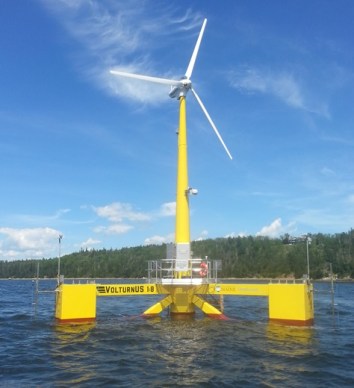
UMaine’s VolturnUS 1:8 prototype, the first offshore wind turbine connected to the North American grid
Much of my research experience and focus is in floating offshore wind turbines, the technology of putting wind turbines on floating support structures so that wind energy can be harvested over deeper waters. Most of the world's surface wind resource is over deep waters, so floating wind technology dramatically expands the feasible wind resource. My research has sought to contribute along several lines: design optimization techniques, better simulation tools, and more versatile testing capabilities.
Floating wind turbines involve a complex combination of aerodynamic, hydrodynamic, and structural engineering considerations. I have applied my skills in those areas to other renewable energy technologies as well, including onshore wind turbines, tidal turbines, and wave energy converters. I believe that we can advance these technologies most efficiently by promoting crossover and commonality in their design methods.
Shared Mooring Systems
Shared mooring systems are solution for improving mooring system efficiency in deep water. The idea is to directly interconnect adjacent floating platforms with mooring lines, thereby reducing the required number of anchors and mooring lines descending to the seabed. Shared mooring lines couple the dynamic response of a floating array, complicating the design problem, but the potential reductions to mooring system cost and space use in deep-water sites are considerable. I began researching this topic at UPEI with student Patrick Connolly, looking at dynamics modeling approaches, resonance phenomena (Patrick's Honours thesis), and performance and cost characteristics of pilot-scale design concepts.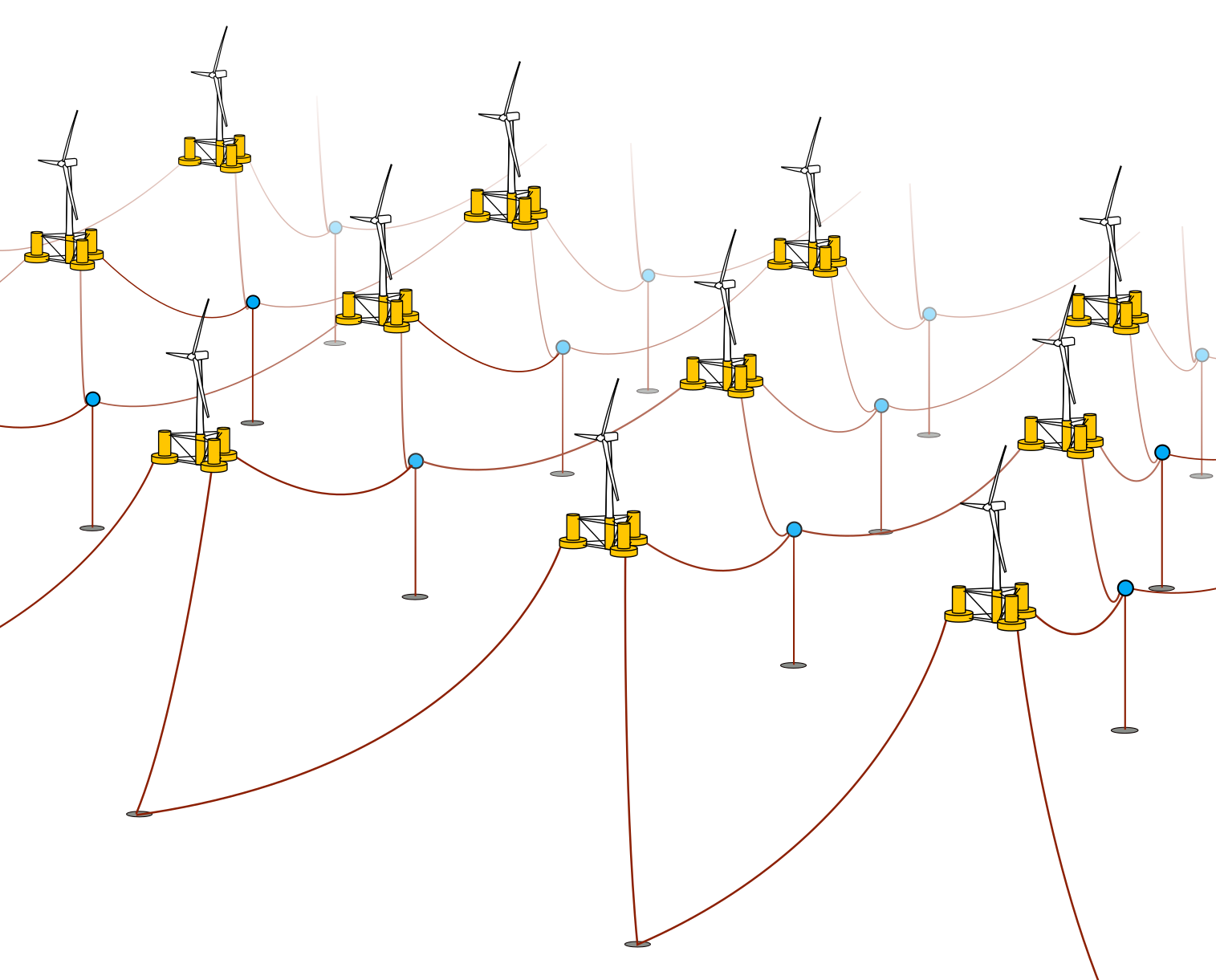
A shared-mooring idea I showed at the 2018 International Offshore Wind Partnering Forum
Mooring System Dynamics Modeling
New offshore wind, tidal, and wave energy technologies are demanding increasingly sophisticated mooring systems, which can involve spring or buoyancy components, synthetic ropes, and connections between different mooring lines. I developed and lead the ongoing improvement of the MoorDyn model, which is used to simulate mooring lines and dynamic power cables in OpenFAST, WEC-Sim, and a number of other marine structure simulation tools.
Tidal and Wave Energy Modeling
At UPEI, my lab group took on several wave and tidal energy modeling and analysis projects: Developing a coupling for simulating tidal rotor hydrodynamics in the ProteusDS simulation tool with DSA Ocean. Modeling a moored wave buoy with MarineLabs. Creating and using a current drogue to measure the current speeds in the Hillsborough River and assess tidal power potential for the City of Charlottetown.
Sustainable Energy Systems
At UPEI I also did research on sustainable energy systems — studying at a higher level the combination of different energy sources along with energy needs, social stances, and environmental constraints that can inform decisions about what future opportunities for a more sustainable energy future could look like. This involves looking at energy resources and consumption, applying techno-economic optimization tools, and collaborating with other disciplines on energy transition visioning. As part of this I contributed to Sustainable Canada dialogues, a Canada-wide collaboration of professors addressing the climate change imperitive from a multidisciplinary perspective. [Re-energizing Canada report]
Renewable Energy Integration in PEI
Using local electricity supply and demand data and models, I looked at scenarios for a 100% Renewable Electricity Supply for PEI with colleague Andrew Swingler, identifying minimum-cost renewable generation and storage sizes that could meet instantaneous demand on PEI with electricity import/export. This is an informative limit case when considering future electricity system options in PEI.
Accessible Electricity System Modeling
I developed my models into an open-source and accessible island renewable energy integration simulator with Matt McCarville in a project for the Canadian Energy Modeling Initiataive. The model combines a Python backend with an Excel spreadsheet user interface so that it is both customizable and easy to use.
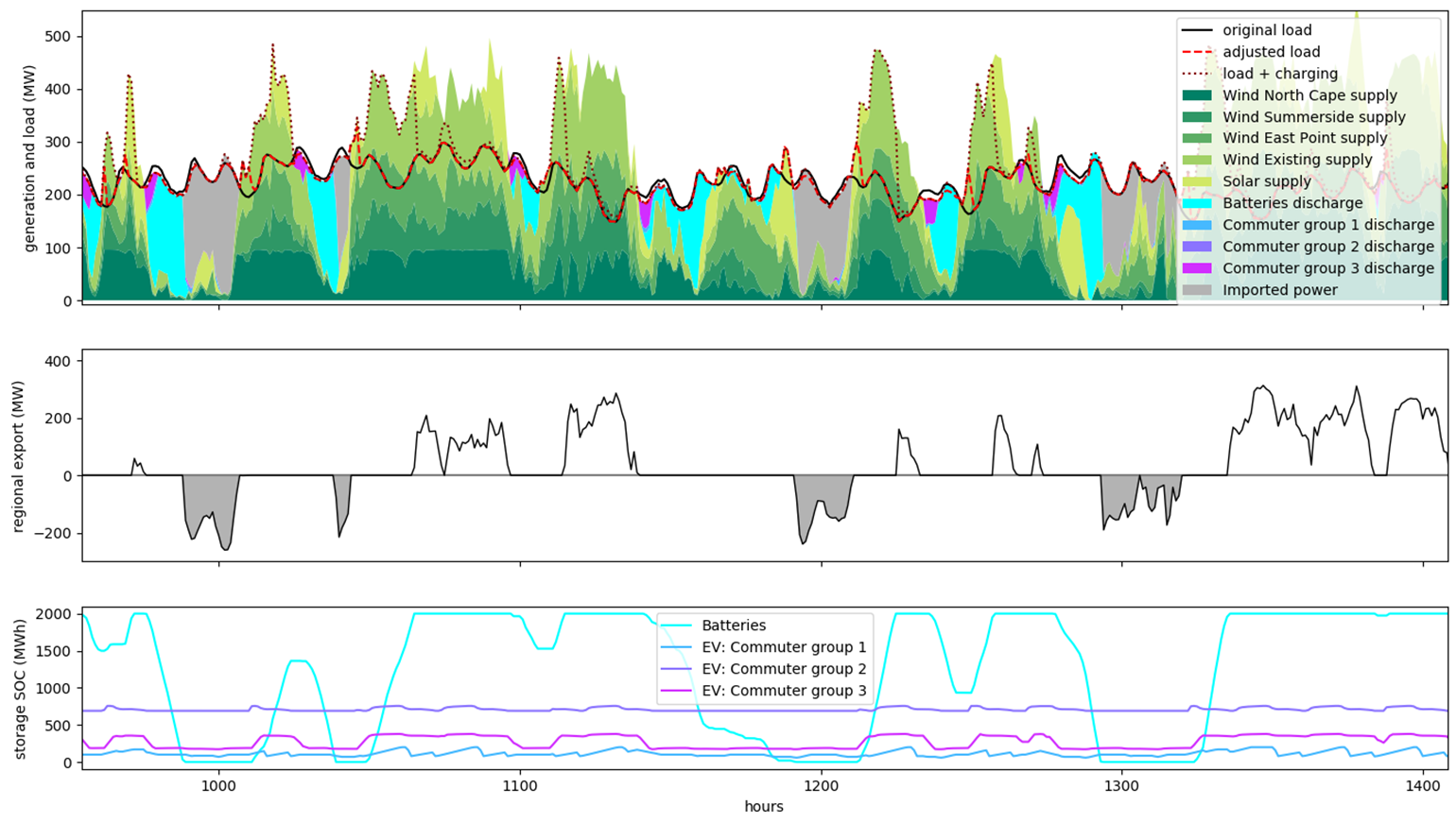
PhD Research
Hybrid Modeling (Hardware-in-the-loop Testing) of Floating Wind Turbines
My PhD research at UMaine, advised by Andrew Goupee, looked at combining simulations and experiments to better model floating wind turbines. I developed a real-time coupling of numerical and physical models, which can be used to provide a more versatile representation of aerodynamic forces when testing floating wind turbine designs at small scale in wave basins. In 1:50-scale tests, we demonstrated than an actuation system coupled with a real-time wind turbine simulation could provide more true-to-scale aerodynamic loads than conventional methods. My PhD thesis can be found here.
Mooring Line Dynamics Modeling
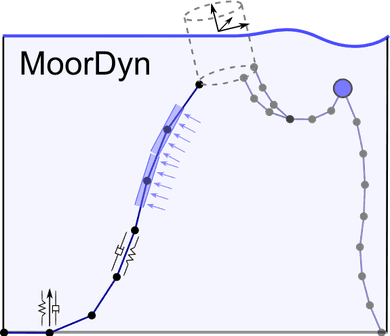
I created an efficient open-source dynamic mooring line model to fill the gap between free quasi-static models and sophisticated commercial dynamic models. MoorDyn is available for stand-alone use and also is part of several existing offshore renewable energy simulation tools. This is a topic of ongoing work. See the MoorDyn page for details.
Masters Research
My masters research at the University of Victoria, supervised by Curran Crawford and Brad Buckham, looked at several projects about floating wind turbines: support structure design optimization, floating platform optimization via basis functions, and mooring line modelling requirements. My MASc thesis can be found here. Information about the three masters projects is below.
Floating Wind Support Structure Optimization via Genetic Algorithm
The support structure (floating platform and mooring system) design problem is complicated by a number of competing objectives and an overwhelming number of design options. The wide range of platform configurations makes searching for good designs using parameter studies and optimization techniques challenging — there are many parameters and many discontinuities in the design space.
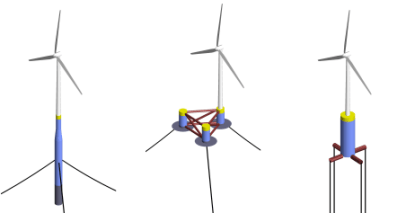 I created a global support structure optimization framework to address these challenges. Using a 9-variable parameterization, a frequency-domain hydrodynamics model supplemented with linearized viscous drag terms, and a genetic algorithm optimizer, the framework spans a much larger extent of the design space than any previous optimization tools. [OCEANS Paper]
I created a global support structure optimization framework to address these challenges. Using a 9-variable parameterization, a frequency-domain hydrodynamics model supplemented with linearized viscous drag terms, and a genetic algorithm optimizer, the framework spans a much larger extent of the design space than any previous optimization tools. [OCEANS Paper]
I also created a new genetic algorithm for the framework, the "Cumulative Multi-Niching Genetic Algorithm" (CMNGA). It can converge to multiple local optima and keeps a record of all evaluated design points in order to reduce the number of dynamics evaluations required for convergence. [IJARAI Paper | CMNGA in Matlab]
Floating Wind Platform Optimization via Basis Functions
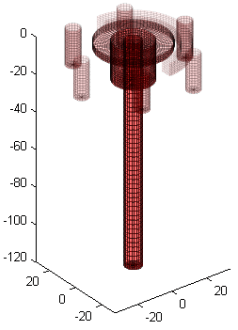 Traditional platform optimization approaches apply assumptions to parameterize the geometry and then perform repeated numerical simulations to find optimal design variable values. I explored more generalized and intuitive approaches that are based more on performance principles than platform geometry. The goal was to explore the design space more efficiently and intuitively than the traditional approach. I tried a “basis function” approach. I had serious limitations but may serve as a useful starting point for better approaches. [AIAA Paper | Renewable Energy Paper]
Traditional platform optimization approaches apply assumptions to parameterize the geometry and then perform repeated numerical simulations to find optimal design variable values. I explored more generalized and intuitive approaches that are based more on performance principles than platform geometry. The goal was to explore the design space more efficiently and intuitively than the traditional approach. I tried a “basis function” approach. I had serious limitations but may serve as a useful starting point for better approaches. [AIAA Paper | Renewable Energy Paper]
Limitations of Quasi-Static Mooring Models for Floating Wind Turbines
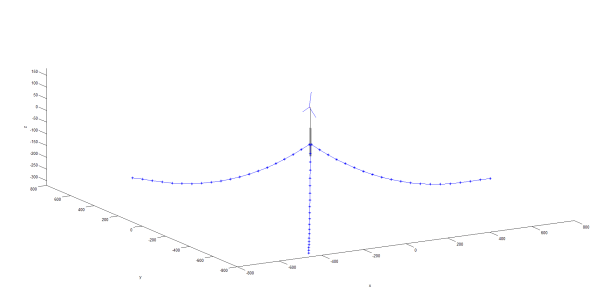
In 2010, NREL’s floating wind turbine simulator (FAST v7) used a quasi-static mooring model, which ignores dynamic effects on the mooring lines. I modified FAST, coupling its platform motions to ProteusDS, a highly-accurage dynamic mooring line model made by DSA Ocean. I used this coupling to quantify the inaccuracies of relying on a quasi-static mooring model for different wind turbine designs and operating conditions.
| OCEANS Paper | Wind Energy Paper |